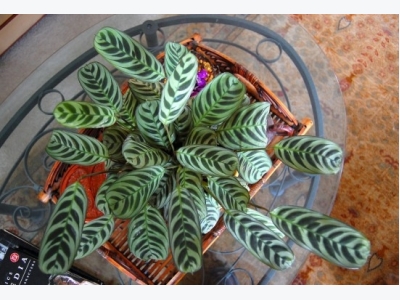How to Grow a Prayer Plant

With beautiful foliage and easy maintenance, the prayer plant (Marantaceae) is a lovely exotic house plant to enjoy indoors.
The prayer plant is best known for its habit of folding and bending its leaves upright in the evening which gives it the appearance of being in prayer. The prayer effect is enhanced by the intense color patterns of the leaves.
A ground plant native to the dense tropical forests of Central and South America, the prayer plant is tolerant of low-light conditions. Its striking colors and its ability to thrive in darker locations make the prayer plant an inspiring addition to home or office. Outdoors, the prayer plant can be grown in the United States Department of Agriculture hardiness zones 11 and 12. They love warmth and humidity.
How to grow and care for a prayer plant
Indoor and outdoor prayer plants are easy to start from divisions. To start new plants, remove the parent plant from the pot or from the ground and pry apart the stems leaving plenty of root on each stem. Replant immediately before the roots dry. The soil for your prayer plant should be slightly acidic, so a little peat moss mixed into your potting soil will add that acidity. You should fertilize with a balanced acid food every two weeks from spring through fall.
A prayer plant is best grown in temperatures ranging between 60 and 85 degrees. Greenhouses and terrariums are the ideal locations for these plants because they provide humidity and filtered light. Create humidity for your plant at home or in your office by placing it among other plants. This creates a little bubble of humidity for the prayer plant. You can also place a dish full of water near your plant to create humidity or mist your plant with warm water daily.
Avoid direct sunlight. Outdoors, plant your prayer plant in a warm but shady location. Water your prayer plant so that the soil is evenly moist but never soggy. During the winter, allow the soil to become slightly dry before watering. Maintain the humidity around the plant year-round.
Prayer plant pests and problems
As with most houseplants, the prayer plant is susceptible to spider mites, mealy bugs, and aphids if it is not properly managed. Maintain the prayer plant's humidity and the moisture in the soil to prevent these pests. Inspect your prayer plant routinely, and keep your new or transplanted prayer plant away from other plants until you know it is clean. Make sure any plants adjacent to your prayer plant are clean as well to prevent a crossover infestation
If you notice that the tips of the leaves of your plant are browning or curling up, it is probably getting too much light. If you have ensured that your plant is receiving the proper amount of indirect light, it may also be sensitive to the chlorine in tap water. Try watering with bottled water, or let tap water sit for a day before watering your plant with it.
Prayer plant varieties worth considering
"Arrowroot" is a valued as a food plant rather than just as an ornamental. Its underground rhizomes have been used throughout history. Originally believed to be an antidote to poisoned arrows, native people taught early colonists to call it arrowroot. Today, arrowroot is an ingredient found in ice cream, crackers and cookies.
"Erythroneura" is a popular choice for aesthetic purposes. It boasts dark green leaves with yellow markings and red herringbone patterned veins which provide a striking contrast.
"Massangeana" provides another striking beauty with black-green leaves and silver veins.
Related news
 How to Grow Catmint
How to Grow Catmint Catmint (Nepata) is a glorious plant for the mixed bed or perennial garden. It tolerates heat, drought and poor soil and spreads quickly
 How to Grow Cornflower (Bachelor Button)
How to Grow Cornflower (Bachelor Button) It's a great plant selection for a newbie gardener or the most seasoned growers out there. Its simple beauty has made it a reliable mainstay in gardens since
 How to Grow Pampas Grass
How to Grow Pampas Grass Pampas grass (Cortaderia selloana), with its showy flowers and soft, billowing form, brings to mind Florida coastal regions and balmy climates.